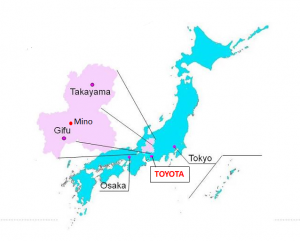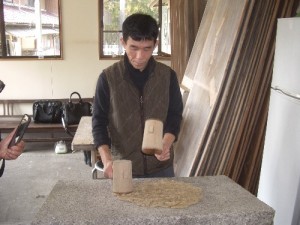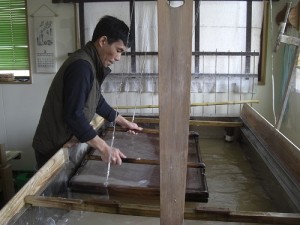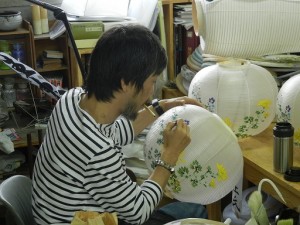 Gifu Prefecture is west of Tokyo, east of Osaka and situated in the centre of Japan.
Gifu Prefecture is west of Tokyo, east of Osaka and situated in the centre of Japan.
As well as the development of Toyota Motors nearby, there is also a concentration in the area of industries and business relating to automobile production and aviation.
At the same time, there have also been various attraction from ancient times. There are many famous sights, such as the sloping roofs of thatched dwellings in the Japanese ‘gassho’ style in Shirakawa-go, the historical streetscapes which last to this day of ‘Hida Takayama’, and one of Japan’s famous three onsen (hot springs) at ‘Gero Onsen’. Also, there is the blessed natural environment in which a rich local cuisine has developed, and the attractions of traditional industries such as washi paper, ceramics, knives, woodworking and furniture.
 In 2014, mino-washi made in Gifu Prefecture (specially designated paper from the region) was also included in the Japanese art of handmade washi paper registered as an ‘intangible cultural heritage’ by UNESCO.
In 2014, mino-washi made in Gifu Prefecture (specially designated paper from the region) was also included in the Japanese art of handmade washi paper registered as an ‘intangible cultural heritage’ by UNESCO.
The Mino area, which is the ancient name of the province in the south of Gifu Prefecture, and where still today the same name is used for Mino City, has been celebrated as an area producing washi for over 1,300 years. The reason for the development of the washi industry is said to be because of clean water from the river used in the production process and being able to use the river for transporting.
These days, mino-washi is chiefly used to make traditional shoji sliding doors (commonly found in Japanese houses), but it has also been used for the repair of works of art in such places as the British Museum. ‘Mino Tissue’ as it is called, is a fine paper, but is sturdy enough that it will not break even when wet. It is mainly used in the repair of Japanese paintings, but is also used in part when repairing other works of fine art.
 However, the demand for mino-washi declines year by year, and it is getting more and more difficult to sustain the industry in traditional ways. In order to protect the ‘washi’ industry local authorities (led by Mino-city) and workers cooperatives are working together to raise awareness of the industry.
However, the demand for mino-washi declines year by year, and it is getting more and more difficult to sustain the industry in traditional ways. In order to protect the ‘washi’ industry local authorities (led by Mino-city) and workers cooperatives are working together to raise awareness of the industry.
In the past, the centre of Mino city was the site of many wholesalers of mino-washi, and this preserved town house area is now used to hold an event named the ‘Minowashi Akari Exhibition’ in October of every year to teach ever more people about the tradition. Also, educating local young people about ‘papermaking’ is also supported. In primary schools within the city throughout the year dedicated workshops are held for all year groups on the production of mino-washi. When the students come to their final year, their graduation diplomas are presented made of the paper they have made through their own hard work. The workers cooperatives have been working on making the ‘mino-washi brand’, which while protecting the traditional manufacture of paper also looks at the possibilities for new products made from mino-washi. The aim of this is to increase demand not just in Japan but also the expansion of overseas markets.


